Exploring Fantasy in Metal, Part II: Six Albums In the Dark of Night
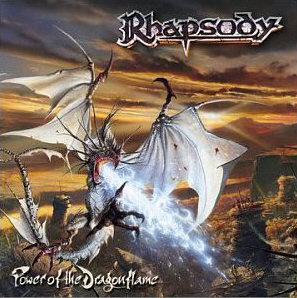 Once upon a time, on a dark winter’s night, a black-clad adventurer came to my apartment to tutor me in the ways of Heavy Metal. Such Metal, that is, as pertained to my favorite genre ever, Fantasy. The long and fraught road leading to this nocturnal excursion can be found here, if you care for a saga’s beginnings.
Once upon a time, on a dark winter’s night, a black-clad adventurer came to my apartment to tutor me in the ways of Heavy Metal. Such Metal, that is, as pertained to my favorite genre ever, Fantasy. The long and fraught road leading to this nocturnal excursion can be found here, if you care for a saga’s beginnings.
So there we were. We sat on the floor of my bedroom. I was nervous and babbling; he was amused and patient. Before us like a Tarot spread: six CDs, each with songs or themes based in the fantastical or epic.
The night was long, but not infinite. Neither were my powers of concentration, my will, or my bladder.
In order to preserve my sanity, I asked Metal Master Sam to choose one or two songs from each of the six albums that best typified the whole. I felt a little guilty making him do all the work, but we had to focus.
Focus we did. We listened to two songs on every album but The Odyssey. We only listened to Track 8, “The Odyssey” on “The Odyssey,” because it was perforce very long. One cannot, after all, embark on only part of an Odyssey. It’s unseemly. More on that later.
1. Summoning’s Oath Bound
Songs: “Land of the Dead” and “Mirdautas Vras”
Subgenre: Symphonic Black Metal, AKA “Tolkien Metal”
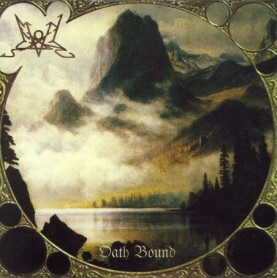 In the genre of Tolkien Metal, the Austrian band Summoning is celebrated for immersing itself in Middle Earth. “Chronically wistful,” says Sam the Sommelier. “Archaic. Old World. Folksy.”
In the genre of Tolkien Metal, the Austrian band Summoning is celebrated for immersing itself in Middle Earth. “Chronically wistful,” says Sam the Sommelier. “Archaic. Old World. Folksy.”
I sort of get it. “Land of the Dead” is somehow grand and sad and sweet – if a little cheesy. A chorus joins the soloist in a rising wave of sound. A synthesized flute drifts over the mass of voices. It’s all there: “A romanticized paean to heroes and glory – the Land of the Dead, heroes of the sky, etc, etc.” Sam pauses, shrugs. “Mostly in tune and drenched in reverb.”
Derisively called “Casio Metal” after the keyboard used, Oathbound’s sound has an MS-DOS fantasy game quality. But if you get past that, submerge yourself in a LOTR mindset, while accessing your inner eleven year old who sits alone in a basement dreaming of valor and orcs, it can be very stirring.
Speaking of ORCS! Sometimes, a girl just wants to hear orc horns in her music. Where can she turn? To whom does she go? Why, she goes to Track 3 of Oathbound: “Mirdautas Vras,” (rough translation: “It is a good day to kill”). Not only will she get awesome orc horns, she’ll get war drums, marching, scary voices singing in the Black Speech of Mordor, bestial roars, and “a polka-like low brass in the background.” Check out these lyrics:
To North ride on, a thousand orcs
On wolves with giant bloody fangs
Then take the storm and power
Of Mordor through the world.
2. Amon Amarth’s With Oden On Our Side
Songs: “Asator” (another name for Thor) and “Hermod’s Ride to Hell”
Subgenre: Viking Metal (With elements of Death Metal in the vocals and percussion)
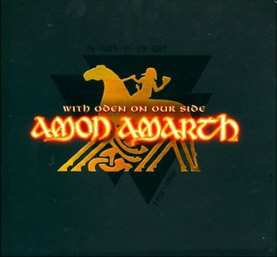 “Asator” is fast and furious, full of monsters screaming about fire, fire, and lots more fire. “Fire” is about the only word I can understand.
“Asator” is fast and furious, full of monsters screaming about fire, fire, and lots more fire. “Fire” is about the only word I can understand.
“Are they singing about fire, Sam?”
“It’s one of their favorite things.”
“Fire?!”
“It’s a theme in their artwork,” he explains.
I read along with the lyrics to get a better sense of the song. Sam’s learned by now that this is the only way I can concentrate on a song specifically enough to enjoy it. In Metal, the words are not as vital as how they sound, but I can’t seem to like this music for the sake of its sound alone. “Asator” is a song about Thor. Knowing even that much, to me, makes it more interesting.
All brave men with hearts of war
Ride the path to mighty Thor
Son of Thunder, Son of Oden
Thunder God, Master of War.
They’re not the best lyrics, but they paint a picture for me. A harsh one, full of fire.
After “Asator,” we click over to “Hermod’s Ride to Hel – Loke’s Treachery Part I.” I listen for a while, riffle through the pages of the insert. As far as I can see, there is no “Loke’s Treachery Part II.” I decide not to mention it.
“Is that how you pronounce Niflheim? Niffle-HAME?”
“Sure.”
“I thought it was Niffle-HIME?”
“I would’ve said that, but who am I to doubt them?”
“You’re Sam!”
“Yes, but they’re Swedish.”
Hermod is the narrator for most of “Hermod’s Ride to Hel.” He drives the horse Sleipner to “the dark realms of the world.” The music matches his urgency, surging forward with a hero’s bombastic bravery, until at last Hermod confronts the goddess of the underworld and demands Balder back for the mourning Earth.
Then the song switches. Hel speaks, and everything changes. The line grows more lyrical. The vocal production is layered and eerie. She tells him:
If it’s true what you say to me
That the whole world mourns his death
If the whole world will weep
I will give him back his breath.
The song ends on this cliffhanger. Does Hermod’s ride succeed? Does the whole world weep indeed? Is Balder released from Hel’s realm?
Well, no. Duh. You know the answer from the title.
3. Edge of Sanity’s Crimson II
Songs: Well, that got a bit difficult, actually… See below
Subgenre: Melodic Death Metal
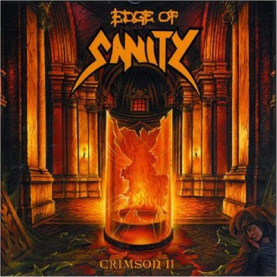 You’ll maybe notice that I didn’t write down the titles to the songs we listened to. That’s ‘cause there weren’t any.
You’ll maybe notice that I didn’t write down the titles to the songs we listened to. That’s ‘cause there weren’t any.
Crimson II consists of forty one-minute songs each on a separate track, these all being herded under nine umbrella-like Movements. The Movements, at least, have names. And Roman Numerals.
In Crimson II, there is a child-queen with Sith-like powers of mind-control through her singularly deadly gaze. A group of doughty women (including the evil child’s mother) set out on a quest to conquer the child, AKA The Crimson Queen – to put out her eyes, which will “stunt the growth of nascent power that grows within her like some poisonous flower.”
This pisses the kid off, of course, and everyone on the quest dies, but then her mother ends up tricking her baby girl long enough to blind her, and they both up decaying together forever in a sealed chamber.
As a band, Edge of Sanity does not always focus on mythology or a self-created fantasy world, but for the Crimson Saga (Crimson II is a sequel, I learned, to “Crimson.” Go figure.), they created an entire storyline, a feat that, Sam says, is “far from uncommon in Metal and one of the finer qualities of the genre at large.”
“Yes, but what makes it Melodic Death Metal?”
“Well, it’s rooted in Death Metal, but…”
“It’s easier on the ears?”
“Definitely.”
Crimson II does lack the harsh edge of some Metal. There are hints of the Wagnerian in Edge of Sanity’s use of musical themes to denote different passages and concepts.
Also, the heroes and villains in this particular world are all women: from the infanticidal and prophetic Mother Superior to the Crimson Queen herself. Sort of unexpected, if you ask me. But cool.
4. Symphony X’s The Odyssey
Songs: Track 8, “The Odyssey.” Yes. The whole dang thing. A 24-minute-long song, and we listened without stopping, thank you. Whoever said our generation has no attention span?
Subgenre: Progressive Metal
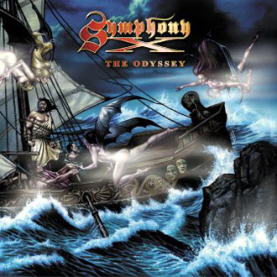 The whole album here is not a concept album, but most of the songs are fantastic in origin. There is a magician’s apprentice track, for example, in Track III “Incantations of the Apprentice.” But we didn’t really concern ourselves with these. We focused on the Seven-Part finale from which the album’s name was derived.
The whole album here is not a concept album, but most of the songs are fantastic in origin. There is a magician’s apprentice track, for example, in Track III “Incantations of the Apprentice.” But we didn’t really concern ourselves with these. We focused on the Seven-Part finale from which the album’s name was derived.
I mean, it’s hard to condense the entire Odyssey in 24 minutes, but Symphony X sure tried.
The vocalist is a bit swoony, but flexible and fun enough to carry off the song admirably. He starts off by bemoaning, in the person of Odysseus, the many years he’s been away from home:
Seasons of sorrow have stolen all my years
I miss the rolling hills of Ithaca
I’ve been through battles and cried a sea of tears
But the tide is changing…
Entire passages of action are condensed into wholly musical interludes, as in part six, the lyricless “Scylla and Charybdis.” If Symphony X’s “The Odyssey” lacks anything, it’s a strong conclusion. One wants to see Odysseus deal with his wife’s suitors in a nice bloodbathy sort of way. Kind of like his comeuppance for being gone so long. We want to see him cast off his beggar’s cloak and string his mighty bow, but all he does is give his upcoming vengeance a mention:
I spy so many who eye my Queen
I’ll make them pay for this blasphemy
All will see.
Yeah, you tell ‘em, Odysseus! Of course, my personal favorite was part IV, “Circe,” when they “carouse with the maiden/ beneath her eyes the madness lies… in mystery.”
I always did like Circe. And the consequences of carousing with her. She deserves her own concept album, I think.
5. Rhapsody (of Fire)’s Power of the Dragonflame
Songs: “In Tenebris” and “Lamento Eroico” (sung in Italian!)
Subgenre: “Hollywood Metal” or “Power Metal with some Symphonic Qualities”
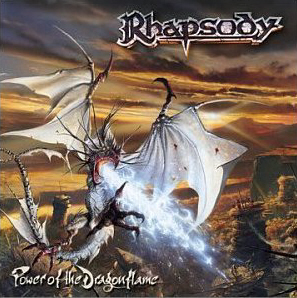 It is explained to me that Power Metal is known for its bombastic intro tracks. And indeed, the first track of Dragon Flame is full of clashing, fluttering, galloping drums, real violins and a full S-A-T-B baroque choir. There is a vocalist named Fabio who sings about “the night rider of doom.”
It is explained to me that Power Metal is known for its bombastic intro tracks. And indeed, the first track of Dragon Flame is full of clashing, fluttering, galloping drums, real violins and a full S-A-T-B baroque choir. There is a vocalist named Fabio who sings about “the night rider of doom.”
This is a full on, no holds barred, Dungeons and Dragons-type Fantasy world they have going on here. The libretto begins with the “Algalord Chronicles, Part IV” and speaks of “winged demons, giant worms, the living dead and vampires.” There is a map as well, featuring such places as “The Darklands” and “The Forest of Unicorns.” It is all very soulful and takes itself very seriously, and you can’t help getting into that a little, the “popera 80’s ballad-ness” of it – for passion’s sake.
“Lamento Eroico” or “The Heroic Lament” is sung in heartrending Italian, with air drums and a lachrymose choir that fades out into a flute.
Dragon Trivia: British actor Sir Christopher Lee has recorded a duet with Fabio on his own fantasy/symphonic concept album. The story goes, Lee is the direct descendant of Charles the Great himself, and thus, of The Hammer, “self-proclaimed saviour of Europe and smasher of the heathen invaders.” The album is called, naturally, “Charlemagne.”
6. Ayreon’s Into the Electric Castle
Songs: We kept skipping around… Details to come
Subgenre: Progressive Metal, or “Rock.” (Rockin’ SPACE OPERA, that is!)
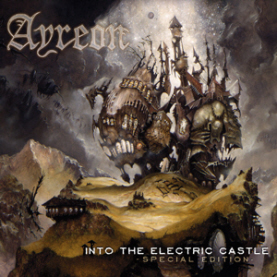 If Rhapsody’s “Power of the Dragon Flame” was like Dungeons and Dragons, Ayreon’s “Electric Castle” is a bit like a Choose Your Own Adventure. Ayreon is known for “hyper-clean production and noodly keyboard arpeggios.”
If Rhapsody’s “Power of the Dragon Flame” was like Dungeons and Dragons, Ayreon’s “Electric Castle” is a bit like a Choose Your Own Adventure. Ayreon is known for “hyper-clean production and noodly keyboard arpeggios.”
In Track I, “Welcome to the New Dimension,” we are told:
You are eight souls of the flesh, chosen from different eras ancient and modern… You have a task… you must enter the nuclear portals of the Electric Castle!
Track II is a sort of dialogue between a Highlander, a Knight, an Indian, an Egyptian, and a Roman. (Later we meet the Barbarian, the Hippie, and the Futureman.) They each have an opinion about what the Electric Castle really is, whether it’s a “Realm fashioned by the Devil’s ane hand,” or “The gates of Avalon, the Island of Spirits” or the halls of Isis and Osiris. The music is vaguely Celtic, with an acoustic 12-string guitar. “I’m rooting for the Egyptians,” I say. “They’re girls.”
“The barbarian has the best song,” Sam counters.
“The Barbarian is not in the opening.”
“I’ll play that one next. He has his moment.”
So he does. The Barbarian gets this very cool line in Track III A.) “Amazing Flight in Space,” with extra points for use of the word “gusto”:
Gods forbid I am no coward!
Pitted against monster, man or ghost
I’d wield my blade with crimson gusto
For I’m the proud barbarian host.
By the time we got to the Barbarian, I was a bit brain-blitzed. I might have hallucinated him.
“Sam,” I muse dreamily, “when you listen to this scary monster music, do you ever imagine it’s a whole bunch of huge shaggy purple Muppets wearing Viking armor in some underground opera house and singing?”
“Uh, no. Can’t say that I do.”
“Oh. Guess it’s just me then.”
Concluded in Part III
[…] Continued in Part II. […]
when you conclude this odyssey try the latvian band Skkyforger, their work Zobena Dziesma is latvian folk, a great album, the rest of their discography is death metal, too hard for me…
http://www.youtube.com/watch?v=NLRdaEfmNd0&feature=related
Francisco…
I have a couple Rhapsody (now Rhapsody of Fire, I believe) CDs. Their sound is moderately diverse from track to track, but it all loiters around symphonic epic metal. The songs on both mine are in English, and there are a dozen or more pages of liner notes in each.
In addition to the map and some silly pictures of band members, you get a several-hundred-word of recap of the story being told over multiple CDs.
I enjoy the music and the story as told in song, but not the dramatic reading bits, which are as silly as the band pictures. On Rain of a Thousand Flames there’s several minutes of it, which was enough for me to load the CD into iTunes, cut out the offending track, and burn a CD I can actually listen to. But, oh, the glorious maps!
Thanks, Francisco! I’ll try to talk someone into listening to Skkyforger (forcing me to listen to it with them) with me. It’s not that I don’t enjoy every second. But it’s like exercise. It requires FORCE OF WILL.
Maps DO excite the imagination, don’t they?
listen to this
http://www.youtube.com/watch?v=kJsxVV4ggLc&feature=related
http://www.youtube.com/watch?v=Xq-n4N63rW8&feature=related
brazilian power symphonic epic metal band Krusader and his work Angus based on a historical fiction book by Orlando Paes Filho, the story of a warrior of viking blood who must fight with the English against the invaders of his same blood in the IX century BC
forget the manga video in the first song and enjoy the vocals ethereal and almost supernatural by the girl in the backing vocals
Cool! Thanks again, Francisco72! I shall have an opportunity to listen to your links very soon (but not while I’m at work).
[…] One and Part Two of that adventure can be found here on the Black Gate […]
Circe definitely deserves her own concept album 🙂